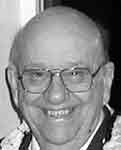JARS v64n1 - The Word: Parenchyma
The Word: Parenchyma
Bruce Palmer
Cutten, CaliforniaIt is now winter in the Northern Hemisphere and the excess food Rhododendron leaves have made during last summer's longer days is now stored for use in the coming spring. This storage process is carried out by cells called parenchyma . The word comes from the Greek words para = beside, en = in and khein = pour; literally to "pour in beside." As is often the case, the term is used in both botany and zoology, but somewhat differently. In zoology, parenchyma tissues and cells are the active sections of organs or the loose, unspecialized cells between organs. In botany, the term is used more broadly, as a defining term for a majority of the live, active cells. Parenchyma cells lack thick cell walls so they are not used for support. The thin walls allow for ready passage of materials into and out of the cells and in the leaves for efficient intake of light energy.
In a leaf these cells are in two groups of tissues between the upper and lower epidermis (Greek: epi = upon and derma = skin). The palisade parenchyma cells are located in one or two layers directly under the upper epidermis. The palisade cells are so named because they are long and thin, stacked side by side, long axis toward the sun. That configuration allows maximum uptake of light energy. It is these cells that carry on most photosynthesis, absorbing carbon dioxide and water, trapping energy from light and manufacturing carbohydrates. Extra atoms are given off as water and oxygen. The process can be expressed as a balanced chemical equation, but we don't need the details here. Beneath the palisade layer is a mass of more or less spherical cells called the spongy parenchyma . The spongy parenchyma tissue and the air spaces between its cells help control the transfer of molecules into and out of the leaf.

|
|---|
Clivia minata root, 10x Photo by Bruce Palmer |
Only a small fraction of the light energy captured in leaves is used by leaf cells. All of the other cells in the plant body also require energetic molecules. The molecules are moved around the plant body to other tissues by the phloem cells we discussed in the previous issue (Vol. 63 (3)) of this journal. After all cells get what they need, there are still excess food molecules that can be stored for future use. That's where those parenchyma cells important in winter become inolved. Storage parenchyma cells are found in the stems and roots, with those in the roots generally being most important. They allow for storage of most of the plant's surplus energy-containing carbohydrate molecules underground where cells will not be as vulnerable to winter weather temperature extremes. These parenchyma cells are arranged in a layer called the cortex, under the epidermis and outside the vascular cylinder, which is the conducting tissue of roots.
A majority of the members of the genus Rhododendron don't lose their leaves during the winter but photosynthesis decreases during the short winter days and colder temperatures. Great quantities of food will be needed a couple months later in the spring when the flowers develop and new shoots and leaves appear, and this energy will largely come from stored carbohydrates. As energy stores are depleted near the top of the plant, osmosis, diffusion and transpiration carry the food molecules stored in the spongy parenchyma cells upward, along with water and needed minerals. That is what happens in the warmer days of late winter as Eastern and Upper Midwest North American farmers produce maple syrup by concentrating sugars by boiling off water from maple tree sap. Once the stored carbohydrates reach developing leaf tissues, new palisade and spongy layers are formed and the new leaves again begin the process of photosynthesis. Meanwhile, flower trusses come and go and seeds form (if we don't deadhead and the flowers are fertile). This cycle is repeated year after year, but our review of words on plant nutrient production and distribution, from transpiration through xylem to parenchyma with associated terms and processes along the way, is now completed.

Bruce Palmer is a member of the Eureka ARS Chapter. He was a teacher of biology at Maui Community College in the University of Hawaii system for 25 years.

